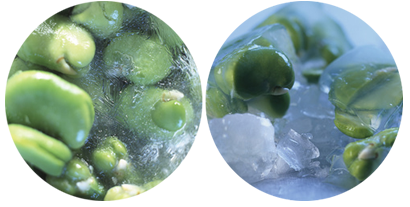
 What about "food freezing" does mean?
What about "food freezing" does mean?
First of all, the purpose why one freeze foods is to prevent their deteriorations.
When foods are storage, they must be needs for protections against putrefactions caused by microorganisms and degradation of nutrition, color, taste, or texture caused by chemical reactions.
Our Strategy for Perishable food preservation:
We think that four factors mainly have impact on the reduction of food qualities,
(1) Chemical reaction,
(2) Enzymatic activity,
(3) Increasing of microorganisms,
(4) Transpiration of water.
We have to remove these factors for preventing the reduction, and it seems to be difficult.
However, the problems will be easily solved by using lower temperature than room temperature.
The refrigeration helps the preservation of foods from such deteriorations.
The temperature is equal to a kinetic energy in molecules composing the substance.
The kinetic energy comes to be lower under lower the temperature, and to be fast under higher temperature.
When the temperature of foods decreases to a certain low degree, the chemical reaction and the enzymatic activity are stopped or slowed down.
Under low temperature, the activity of microorganisms is less activate (but they still be alive), so they cannot make the foods worse.
Since a mobility of water molecule would decrease, the transpiration is also restrained.
Preventions foods from deteriorations by freezing depend on such principle. In the lower degree of storage temperature, we can keep more quality of the foods.
However, ice crystals arise from water in foods under subzero temperature, they make several damages to foods.
Because long storages of the foods should be kept under low temperature, at least in zero degrees celsius, we have to reduce such damages.
If a method, which protects a food from the ice damage, is established, we might be to maintain freshness of the foods, tissues, cells, etc. under low temperature.
What is the best way of freezing them?
There are many kinds of the freezing methods.
For example, if you put a food outdoor in winter night, the food will be frozen in the next morning.
In this way, however, the ice crystals become larger because of a rapid recrystallization, and the texture and taste of thawed one should be worse.
So the ice size is desired as small as possible.
However, even if we use the same freezing methods for various foods, the ice crystals would be in different morphology from each other.
Furthermore, if we want to make the foods frozen well, how should we keep and thawed them?
Therefore, objective of food refrigeration science is to survey the changes water and materials in the foods under the frozen situation and to establish methods how to freeze, keep, and thaw the foods deliciously.
For Sushi and Sashimi
The Japanese people like eating raw tuna, called Sushi and Sashimi.
But it is not easy to get tunas around the Japanese islands.
We are able to eat raw tunas transported from fishing in the Atlantic Ocean or the Indian Ocean.
The freezing is the only possible way to do it. The best way of food's preservation is freezing.
If Since the components of the foods would be modified by denaturation in case of other ways (for examples, the canned food, the retort pouch food due to heat, the dried food same as heat and dehydration, and pickled food acid denaturation), it is impossible to restore the food in row condition.
However, the freezing under enough low temperatures is able to keep the most foods for a long time and to return the quality to as same as the quality before the freezing.
Therefore, the freezing is indispensable for preservation especially in fishery products; those are easy to become worse.
Because of the freezing technique, we can always eat delicious raw fishes.
Merits of Freezing
The freezing preservation does not need any chemical preservatives at all, so it is an exceedingly safe method of the food preservation.
Also, we can make food reserves and long distance transports of foods.
When we achieve the realization of food's demand heijyunnka (heijunka(平準化) is a Japanese term which implies "leveling") and wide-area chains, the freezing will be contributed to food-supply crisis that is one of the most important problems around the world.
Using the freezing, not only the preservation but also several food processing methods are developed recently (for examples a freeze concentration and a freeze dry), many processed foods are created with original fresh flavors.
Past and future
James Harrison in Australia is known as the first person freezing foods in 1855.
The freezing techniques have been developed since about 150 year ago. as the result, our freezing method's level is considered to be high.
But, it has not been completed yet, and we still have unsolved problems.
For example, it has not been cleared the reason why thawed frozen-vegetables wither.
If we reveal that mechanism and make a good way to all foods, the freezing will be contributed to society's construction with sustainable development.
Therefore, we are strongly required to search for a principle and to establish technical developments of the freezing.
The food freezing is a combination of many sciences and techniques, and it is related with physics, chemistry, biology, mechanical engineering, heat transfer engineering, material science, and analyses of them.
Using all knowledge of most advanced science, we face the problem, what does it mean the freezing of foods and lives?
